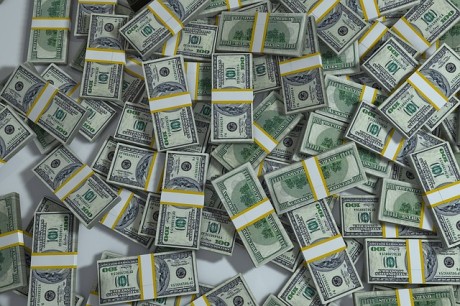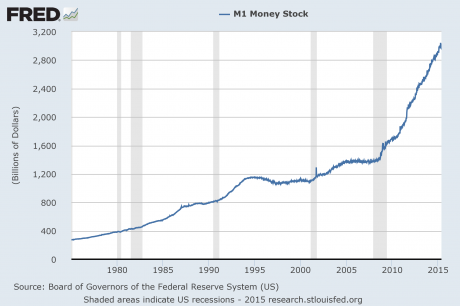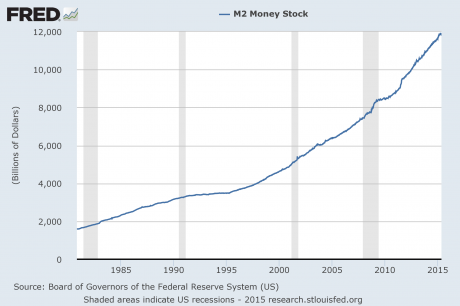It Is Mathematically Impossible To Pay Off All Of Our Debt

Did you know that if you took every single penny away from everyone in the United States that it still would not be enough to pay off the national debt? Today, the debt of the federal government exceeds $145,000 per household, and it is getting worse with each passing year. Many believe that if we paid it off a little bit at a time that we could eventually pay it all off, but as you will see below that isn’t going to work either. It has been projected that “mandatory” federal spending on programs such as Social Security, Medicaid and Medicare plus interest on the national debt will exceed total federal revenue by the year 2025. That is before a single dollar is spent on the U.S. military, homeland security, paying federal workers or building any roads and bridges. So no, we aren’t going to be "paying down" our debt any time in the foreseeable future. And of course it isn’t just our 18 trillion dollar national debt that we need to be concerned about. Overall, Americans are a total of 58 trillion dollars in debt. 35 years ago, that number was sitting at just 4.3 trillion dollars. There is no way in the world that all of that debt can ever be repaid. The only thing that we can hope for now is for this debt bubble to last for as long as possible before it finally explodes.
It shocks many people to learn that our debt is far larger than the total amount of money in existence. So let’s take a few moments and go through some of the numbers.
When most people think of "money", they think of coins, paper money and checking accounts. All of those are contained in one of the most basic measures of money known as M1. The following definition of M1 comes from Investopedia…
A measure of the money supply that includes all physical money, such as coins and currency, as well as demand deposits, checking accounts and Negotiable Order of Withdrawal (NOW) accounts. M1 measures the most liquid components of the money supply, as it contains cash and assets that can quickly be converted to currency.
As you can see from the chart below, M1 has really grown in recent years thanks to rampant quantitative easing by the Federal Reserve. At the moment it is sitting just shy of 3 trillion dollars…

So if you gathered up all coins, all paper currency and all money in everyone’s checking accounts, would that even make much of a dent in our debt?
Nope.
We’ll have to find more "money" to grab.
M2 is a broader definition of money than M1 is, because it includes more things. The following definition of M2 comes from Investopedia…
A measure of money supply that includes cash and checking deposits (M1) as well as near money. “Near money” in M2 includes savings deposits, money market mutual funds and other time deposits, which are less liquid and not as suitable as exchange mediums but can be quickly converted into cash or checking deposits.
As you can see from the chart below, M2 is sitting just short of 12 trillion dollars right now…

That is a lot more "money", but it still wouldn’t pay off our national debt, much less our total debt of 58 trillion dollars.
So is there anything else that we could grab?
Well, the broadest definition of “money” that is commonly used is M3. The following definition of M3 comes from Investopedia…
A measure of money supply that includes M2 as well as large time deposits, institutional money market funds, short-term repurchase agreements and other larger liquid assets. The M3 measurement includes assets that are less liquid than other components of the money supply, and are more closely related to the finances of larger financial institutions and corporations than to those of businesses and individuals. These types of assets are referred to as “near, near money.”
The Federal Reserve no longer provides charts for M3, but according to John Williams of shadowstats.com, M3 is currently sitting somewhere in the neighborhood of 17 trillion dollars.
So even with the broadest possible definition of "money", we simply cannot come up with enough to pay off the debt of the federal government, much less the rest of our debts.
That is not good news at all.
Alternatively, could we just start spending less than we bring in and start paying down the national debt a little bit at a time?
Perhaps that may have been true at one time, but now we are really up against a wall. Our rapidly aging population is going to put an enormous amount of stress on our national finances in the years ahead.
According to U.S. Representative Frank Wolf, interest on the national debt plus "mandatory" spending on programs such as Social Security, Medicare and Medicaid will surpass the total amount of federal revenue by the year 2025. That is before a single penny is spent on homeland security, national defense, paying federal workers, etc.
But even now things are a giant mess. We are told that "deficits are under control", but that is a massive hoax that is based on accounting gimmicks. During fiscal year 2014, the U.S. national debt increased by more than a trillion dollars. That is not "under control" – that is a raging national crisis.
Many believe that that we could improve the situation by raising taxes. And yes, a little bit more could probably be squeezed out of us, but the impact on government finances would be negligible. Since the end of World War II, the amount of tax revenue taken in by the federal government has fluctuated in a range between 15 and 20 percent of GDP no matter what tax rates have been. I believe that it is possible to get up into the low twenties, but that would also be very damaging to our economy and the American public would probably throw a huge temper tantrum.
The real problem, of course, is our out of control spending.
During the past two decades, spending by the federal government has grown 63 percent more rapidly than inflation, and “mandatory” spending on programs such as Social Security, Medicare and Medicaid has actually doubled after you adjust for inflation.
We simply cannot afford to keep spending money like this.
And then there is the matter of interest on the national debt. For the moment, the rest of the world is lending us gigantic mountains of money at ridiculously low interest rates. However, if the average rate of interest on U.S. government debt was just to return to the long-term average, we would be spending more than a trillion dollars a year just in interest on the national debt.
So the best possible environment for "paying down our debt" that we are ever going to see is happening right now. The only place that interest rates on U.S. government debt have to go is up, and our population is going to just keep getting older and more dependent on government programs.
Meanwhile, our overall debt continues to spiral out of control as well. According to CNBC, the total amount of debt that Americans owe has reached a staggering 58.7 trillion dollars…
As the nation entered the 1980s, there was comparatively little debt—just about $4.3 trillion. That was only about 1.5 times the size of gross GDP. Then a funny thing happened.
The gap began to widen during the decade, and then became basically parabolic through the ’90s and into the early part of the 21st century.
Though debt took a brief decline in 2009 as the country limped its way out of the financial crisis, it has climbed again and is now, at $58.7 trillion, 3.3 times the size of GDP and about 13 times what it was in 1980, according to data from the Federal Reserve’s St. Louis branch. (The total debt measure is not to be confused with the $18.2 trillion national debt, which is 102 percent of GDP and is a subset of the total figure.)
As I discussed above, there isn’t enough money in our entire system to even pay off a significant chunk of that debt.
So what happens when the total amount of debt in a society vastly exceeds the total amount of money?
Is there any way out other than collapse?
Disclosure: None.




This comparison of total debt of a country and the total money available does not make sense. What happens with the money that is used for paying back a debt, does it disappear then? No the money will exist further and can be used for paying back other debts. The same amount money can be used several times, and principle infinite times. This is, why it just takes more time to pay back!
I guess USA deliberately doesn't wants to pay off the debts so the money couldn't get into circulation thereby stopping the poor countries from getting loans and developing.
If you take all the national debt in the world and assume it is paid of then who is going to be immensely rich? Every single country need to use more money to keep the society working. The extra money needed is "borrowed", but it is not not real money because no-one will ever use the money. Let the debt be eaten by inflation. In the economy it is important that people work and that they can get everything they need for their daily life. Austerity to pay debt does NOT work if all countries do it - The economic system does NOT work when countries like Germany - Norway, Danmark Sweeden is managing their economic system to have a surplus - then what are poorer countries going to do? Economy is a question of balance - money in national economics is a tool to manage the workforce -and national spending. Some countries must all the time spend more money than they earn to keep the world running. If USA stop to import from China then China will fall into a very severe economic crisis
"manage the workforce"? I think control, or enslave would be more appropriate. In the West, and becoming so in the rest of the world, the vast majority of us are slaves to debt, while the supposedly rich, borrow at low rates while lending at high rates. They, like the banks, have lent far more than they actually have.
I often wonder...There is more money owed, than actually exists.even on paper (or computer). What is the proportion? If the bottom fell out of the property market, worldwide, many of the supposedly mega rich would be broke, banks would fail, and everything that the capitalist world values would disappear.
Almost all nations in the world are in HIGH DEBT,taking a CUE from USA-this is bound to EXPLODE ONE DAY OR THE OTHER-THAT IS FOR SURE.The worldwide inflation especially in developing countries could be TRACED TO THIS MADNESS.If debt is put into good use by getting reasonable return,it is healthy for the economy but is being directed towards WASTEFUL EXPENDITURE.When will the good sense prevail on rulers?Nobody has ever succeeded in life on BORROWED MONEY & THE SAME APPLIES TO COUNTRIES TOO!!
Aside from the practical implications of "owing" large amounts of money, we have to keep in mind two very significant things: First, that mainly we are not talking about an individual or a household, but rather governments, sovereign states; and Second; the entire issue is being raised by someone who seems to have a stake in the matter (which perhaps both raises his level of expertise and his temptation to slant the issue).
There is no doubt that debt is different from "equity" and that due and unpaid debt can have some disastrous consequences. But this current debt is mainly not so simple. And indeed, at some point an unpaid creditor is in just as bad a situation as the defaulting borrower, and both have to good reasons resolve the debt in a good way. So at some level the distinction of debt and equity and virtue and fault is not so clear.
Richard
IMPORTANT INFORMATION - READ THE TRUE FACTS,
There are two scenarios to the issue discussed above about the USA National Debt: It is actualy $18 trillion. The figure of $58 trillion is false because it is Private Debt owed by corporations and private individuals. We will discuss here $18 trillion national debt only because the Private Debt of $58 trillion is invested in businesses or property, all backed by securities except for the unsecured part like credit cards or personal loans which is $1 trillion, a small amount compared to $58 trillion. (the credit card and personal loan companies will charge 12% to 35% while borrowing at 1% to 5% from USA Government - the difference still makes them a hefty profit including the losses from the 10% defaulters, thereby doubling their intial investment in 3-5 years),
1. 1ST SCENARIO:
The National Debt is borrowed by the Government on the basis of 1, 5, 10 or 30 years Treasury Bonds. The crucial factor is that it pays the PRINCIPLE AMOUNT AT THE END OF THE BOND PERIOD. During the life of the Bond the Government ONLY pays INTEREST which can be from 0.25% to 5% maximum. The interest is fixed just above INFLATION RATE. So infact the Goverment pays only the INFLATION RATE. The Result is IT IS FREE MONEY. This Money is invested by the Government in projects which can generate upto 100% ANNUAL RETURN, YEAR AFTER YEAR, which is RE-INVESTED: Example is USA built its major INFRA STRUCTURE in the 50s and 60s. Those investments have paid back many folds. NOTE: At the end of Bond period the Government borrows the PRINCIPLE AMOUNT from ANOTHER LENDER and pays back to the ORIGINAL LENDER, say for 30 years bonds. It needs to do this 3 TIMES in a 100 YEARS or 6 TIMES in 200 years. SO IN FACT THE PRINCIPLE CAN NEVER BE REPAID BACK. ONLY COST IS THE INFLATION RATE. Even if the Government did want to pay back after 200 years the amount to pay would reduce by, maybe less than 10% of the orignal amount due to inflation where as the RETURN FROM THIS FREE MONEY AFTER REPEATED RE-INVESTING THE PROFITS OF 100% WOULD FAR OUT WEIGH THE INTEREST PAYMENTS OVER THE 200 YEARS.
2. 2ND SCENARIO:
The government keeps paying the INTEREST PAYMENTS on the NEVER TO RETURN the MONEY by borrowing from one and paying to other UNTIL - THE DOOMS DAY. You guessed it: ALL DEBTS WOULD BE WIPED CLEAN FROM THE BALANCE SHEETS AS THERE WILL BE NO ONE TO COLLECT THE PRINCIPLE AMOUNT: In other words END OF WORLD = END OF DEBT. NO WORRIES. I dont know how it works in HELL or HEAVEN. I doubt there will be any money needed there or the need for the DEBT COLLECTORS.
SUB-NOTE: US Government can be thrifty and mean in SPENDING this FREE MONEY which causes hardship to the people of USA. OTHERWISE there would be DIFFERENT PROBLEMS: Like nobody would want to work if they started giving away this FREE MONEY to the people.
I HOPE THIS WILL CLEAR THE MATTER. BUT YOU MUST THINK ABOUT IT WITH A FORMATTED MIND, LIKE YOU DO ON A COMPUTER AFTER RE-INSTALLING WINDOWS.
Have a nice day and tell your friends about this NEW DISCOVERY. Maybe a nice person would inform the Nobel Committee about this new discovery then you will watch me on the CNN while in Sweden.
I am, MYSELF
Dated: 25 June 2015
(Sixth day into my 58th year - same as $58 trillions debt, Not a coincidence)
PS: DO NOT INFORM PUBLIC AT LARGE THAT THE BANKERS KNOW THIS. THAT IS WHY THEY HAVE BEEN TAKING A PIECE OF THE FREE MONEY CAKE, example MADOFF, LEHMANS and many many more. That they will find a way around to circumvent ANY TYPE of Rules, Ethics or Regulations. History is my WITNESS, IT KEEPS HAPPENNING.
Same here, mate! It is indeed impossible to pay off any debts at all. Take note all the credit card companies round the world. You know what I am saying?
Its a good idea lets get the Rothschild's into debt. take as much loans as we can and never pay it back..as a matter of facts this banks has made so much money from world citizens. We understand that taxes has been paid towards EDUCATION as the budget is passed towards EDUCATION.This means we have already paid for our education therefore should be for free from primary to university level. Same with Transportation if we recall our taxes that are spread in the budget every fiscal year means we have already pay for our transportation and education and should be made available and free to us. The feds are getting our taxes, then our student loan money..that's double payment.. Rise and call for free education and free transportation same as free health care.
Loading comments, please wait...